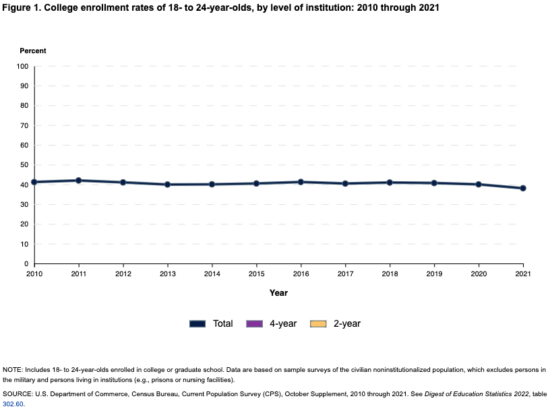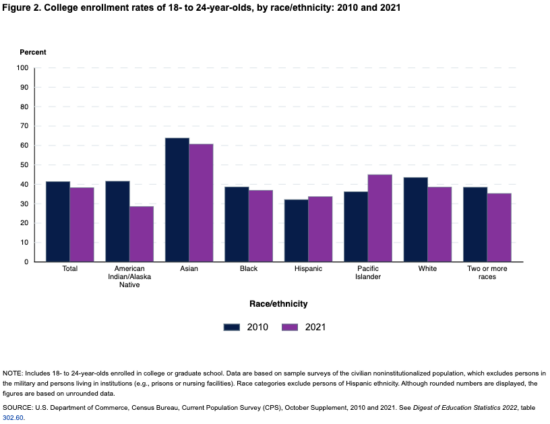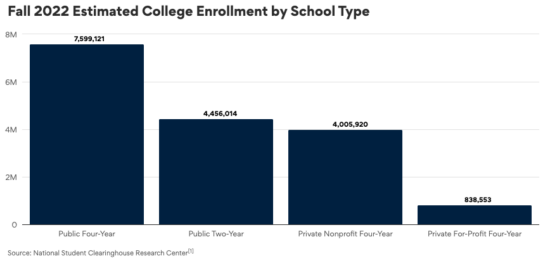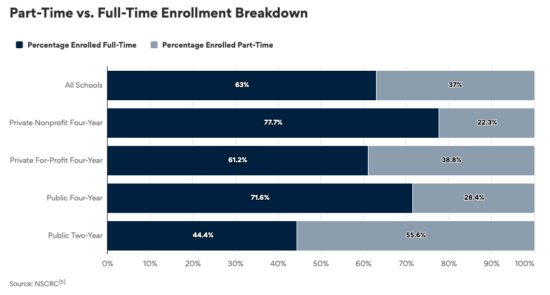The era of the “traditional” college student is over. While many would agree with this sentiment based on anecdotal evidence, it’s prudent to consider the facts in order to make better informed decisions about institutional strategy.
The graph below from the National Center for Education Statistics (NCES) showcases the relative plateauing and drop in college enrollment rates over the past decade.

This long running decline in college student enrollment and the demographics of college students changing is reshaping the dynamics of higher ed. Despite glimmers of optimism in certain specific demographic regions, the prevailing situation in higher education presents challenges for its leaders. It’s important to understand these shifts so students are appropriately recruited, engaged and retained.
The areas outlined in this post are not all of the demographics for consideration, but they are a few key ones helping to better understand this current moment.
Age
When compared to 2020, in 2021, Research.com found the following in regards to the age of current college students:
- Students aged 18-to-20 years old comprise 40% of all undergraduates.
- The enrollment of college students aged 18-to-24 years old declined by 5%.
- The enrollment of college students aged 25 years and up declined by 1.2%.
The takeaway here is difficult to grasp right away from the way the data is presented — 60% of undergraduate students are 21 or older. This is a notable indicator which clearly shows we’re leaving behind the paradigm of the “traditional” college student. The declines for both age groups shown here highlights the overall college population declines are more pronounced for younger students.
Adult learners have unique needs when compared to younger students. It’s important to be mindful of the different life demands of adult learners, such as full-time employment and family caregiving. Helping these overwhelmed students find success is of the utmost importance.
Ethnicity
According to the NCES, from 2010-2021 we see mostly declines across the board in terms of ethnicity representation, with the exception of a very slight increase in Hispanic students and a more pronounced increase in Pacific Islanders.

The takeaway here is while individual ethnic groups experience varied trends of growth and decline, campuses continue to make up a diverse population of students. Each of these groups need to know they matter. It isn’t enough to ensure everyone co-exists — every student must find belonging and their niche within the broader campus community. Leveraging digital communities is a powerful way to accomplish this.
Parental Status
Statistics on this demographic are limited, but the most recent data from the U.S. Government Accountability Office (GAO) says roughly 20% of college students are parents, or approximately 4 million students. This is a decent portion of the college population which warrants attention. In addition, most college student parents are women and people of color, according to data from a NCES study.
These students benefit greatly from a supportive community of peers who can share in the ups and downs of college life while being a parent. It’s often difficult for those who aren’t parents to fully comprehend the struggle it is to balance work, childcare and school. Any sort of similar affinity or life experience like this forges powerful relationships where these students are uniquely able to help one another. Leaders must do their part to enable the space for them to get connected.
Full Time versus Part Time
According to National Student Clearinghouse Research Center (NSCRC) data, the approximate breakdown of full versus part time demographics vary greatly depending on institution type.

The fluctuations in student dynamics are expected to persist and vary based on the mode of learning they choose. Irrespective of the specific figures and proportions, institutions must recognize that a significant portion of students will pursue their studies part-time and may adjust the pace of their degree as needed. This crucial factor is worth consideration when devising strategies to engage students in the campus community.
Institution Type
In regards to enrollment in different institution types, as of 2022 the approximate demographic breakdown heavily skews toward public four-year institutions, according to the NSCRC.

This chart clearly captures the current moment where we’re seeing much lower enrollment in for-profit institutions in addition to the strong preference for public institutions across the country. There is often an outsized emphasis put on high reputation private universities like Harvard or Princeton, but these types of institutions pale in comparison compared to the number of students served by public institutions.
This is helpful to understand when it comes to determining how students are making their college choices. Reputation is important, but value is more important.
Degree Type
When compared to 2020, in 2021, Research.com found the following in regards to the degree sought by current college students:
Associate Degrees
- Associate degree enrollments dropped by 10.9%.
Bachelor’s Degrees
- Bachelor’s degree enrollment dropped by 2.2%.
Graduate Degrees
- Master’s degree enrollment increased by 5.2%.
- Doctoral degree enrollment increased by 3.6%.
Despite declining enrollment numbers, there has been a notable increase in the enrollment of graduate degree programs year-over-year. Therefore, if this trend continues, which we believe it will, it is imperative for institutional leaders to prioritize the support and well-being of these students on par with their undergraduate counterparts. As many master’s and doctoral degree seekers are typically older and choose online learning, there is an added urgency to provide them with flexible digital tools effective in engaging and accommodating their specific learning needs.
Digital Education
As referenced in our recent blog post focused on the “Digital First University,” there are several notable trends when it comes to students studying fully or partially online:
“…more young people fully enroll in online universities than in years past, which mostly consisted of older adult learners. In addition, more students generally take at least some online courses during their studies which allows them greater flexibility in their schedule. We’re also witnessing the growth rate of online students at several institutions increasing at a rapid pace and may be the only area where they increase their student population.”
—
These data points in particular, as well as all of the demographics we shared, provide a clear indication institutions need to plan a hybrid future for their campuses.
There is no going back to the status quo from before the pandemic.
In order to better support modern learners, there must be flexibility and accessibility of all resources a student might need. Investing in the digital infrastructure of a campus will go a long way to better retaining students no matter how they show up in all of the demographics we outlined.
